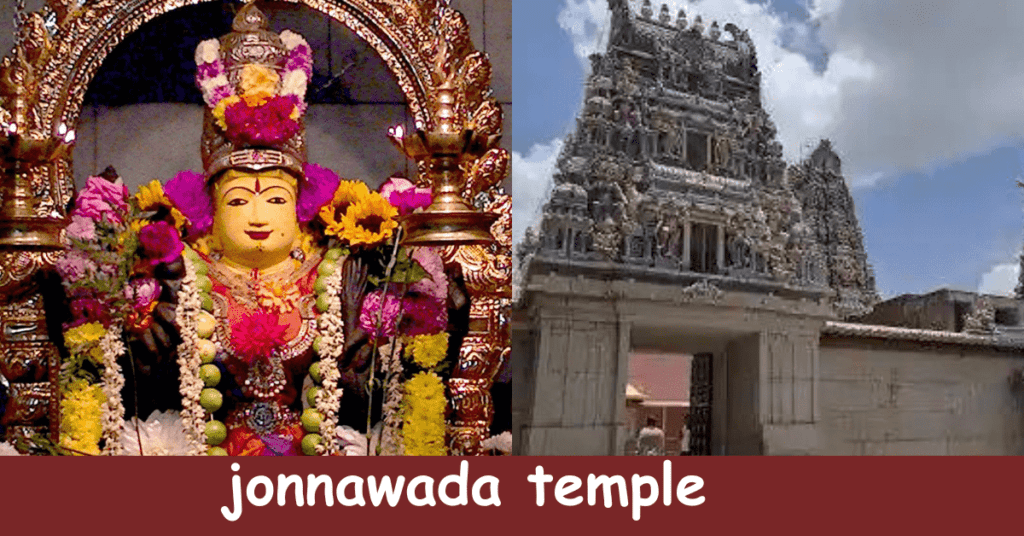Introduction:- Jonnawada, a quaint village located in Andhra Pradesh, India, is renowned for its ancient and sacred temple dedicated to the divine goddess Rajarajeshwari. Nestled amidst lush greenery and serene landscapes, Jonnawada Temple attracts devotees and tourists alike. This article will explore the fascinating history, architectural marvels, essential timings, and unknown facts of the Jonnawada Temple, ensuring an unforgettable spiritual experience.
Unveiling the Rich History of Jonnawada Temple
The Jonnawada Temple holds great historical and mythological significance. Legend has it that the sage Sankara, an ardent devotee of the goddess Rajarajeshwari, built the temple. The temple’s majestic construction, considered over 1,000 years old, perfectly captures the splendor of antiquity. The vibrant sculptures, intricate carvings, and beautifully adorned sanctum sanctorum make it a visual treat for visitors.
Architecture and Design Of Jonnawada Temple
Jonnawada Temple exhibits a unique blend of architectural styles, including the Vijayanagara and Chola styles. The temple’s main entrance, the Mahadwaram, showcases exquisite carvings of deities, celestial beings, and mythological figures. The main shrine, adorned with gold and precious stones, houses the divine idol of Rajarajeshwari. The intricate details and carvings on the temple walls narrate stories from Hindu mythology, adding a sense of spirituality and awe to the complex.

Jonnawada Temple Timings for Divine Darshan
To ensure a fulfilling spiritual experience, planning your visit to Jonnawada Temple during its operational hours is crucial. Here are the temple timings you should keep in mind:
Morning Darshan: The temple opens early, at 6:00 am. The serene ambiance, combined with the gentle rays of the rising sun, creates a magical atmosphere for devotees seeking blessings and solace.
Afternoon Break: The temple closes briefly in the afternoon, allowing the priests to perform rituals and make preparations for the evening rituals. Temple close from 12 pm to 4 pm.
Evening Aarti: The temple reopens at 4:00 pm, welcoming devotees for the evening aarti (prayer ceremony). The divine chants, rhythmic bells, and the fragrance of incense create an enchanting atmosphere, captivating the hearts of all who attend.
Night Rituals: The temple remains open until 8:00 pm, giving devotees ample time to offer their prayers, seek blessings, and experience the tranquil vibes of the temple during the nighttime.
Important Tips for Jonnawada Temple Visitors
Dress Code: As a mark of respect, it is advisable to wear modest attire while visiting Jonnawada Temple. Everyone should cover their knees and shoulders.
Photography and Videography: Photography and videography are generally allowed within the temple premises, but it’s always recommended to seek permission from the authorities before capturing any images.
Festivals and Special Occasions: Jonnawada Temple hosts several grand festivals and celebrations yearly, drawing huge crowds. If you wish to witness the temple at its vibrant best, plan your visit during the annual Brahmotsavam festival or other major events.
unknown facts about Jonnawada temple
While the Jonnawada Temple is well-known for its spiritual significance and architectural beauty, several lesser-known facts add to its allure. Let’s explore some of these intriguing unknown facts about Jonnawada Temple:
Floating Stone: One of the fascinating mysteries surrounding the temple is a floating stone known as “Brahma Sila.” It is believed that this stone floats in water and remains stationary, defying the laws of physics. Devotees consider it a divine miracle and a symbol of the temple’s sacredness.
Underground Tunnels: The Jonnawada Temple is said to have a network of underground tunnels, the purpose and extent of which remain unknown. These tunnels are believed to have served as secret passages for the priests and played a role in safeguarding the temple during invasions and unrest in ancient times.
Hidden Sanctum Sanctorum: The main sanctum sanctorum of the temple, where the idol of Rajarajeshwari is housed, is said to be hidden or concealed. It is thought that only certain priests have entry to the inner chamber, giving an aura of secrecy and privilege to the temple’s innermost area.
Temple’s Magnetic Field: The Jonnawada Temple is said to possess a unique magnetic field. It is believed that the energy radiated by the temple has healing properties and can relieve ailments. Devotees often visit the temple seeking solace and the restoration of their well-being.
Mythical River Kundu: Legend has it that there used to be a mythical river called “Kundu” that flowed near the temple. The river is thought to have become depleted over time. However, its importance and legacy remain embedded in the temple’s history and tradition.
Divine Presence of Sage Sankara: The temple is associated with the revered sage Sankara, who is believed to have been instrumental in its construction. Devotees believe that the divine presence of Sage Sankara can still be felt within the temple premises, enriching the spiritual experience of visitors.
The abundance of Peacocks: The temple surroundings are known for their abundant population of peacocks. These majestic birds, renowned for their vibrant plumage and dignified demeanor, contribute to the natural beauty and peacefulness of the temple’s atmosphere.
Navaratri Celebrations: The Navaratri festival, dedicated to worshiping the goddess Durga, is celebrated with great zeal and enthusiasm at the Jonnawada Temple. The temple witnesses a grand procession and cultural performances during this period, attracting devotees from far and wide.
These lesser-known facts contribute to the mystique and allure of the Jonnawada Temple. They add to the spiritual experience, making visiting the temple an enchanting journey filled with ancient legends, divine miracles, and a sense of awe-inspiring wonder.
Conclusion
Jonnawada Temple stands as a testament to the rich cultural and spiritual heritage of Andhra Pradesh. With its captivating architecture, divine ambiance, and sacred history, it offers a serene retreat for devotees and visitors seeking solace and blessings. By adhering to the temple timings and following the necessary guidelines, you can embark on a memorable spiritual journey and immerse yourself in the divine grace of Rajarajeshwari at the Jonnawada Temple.
